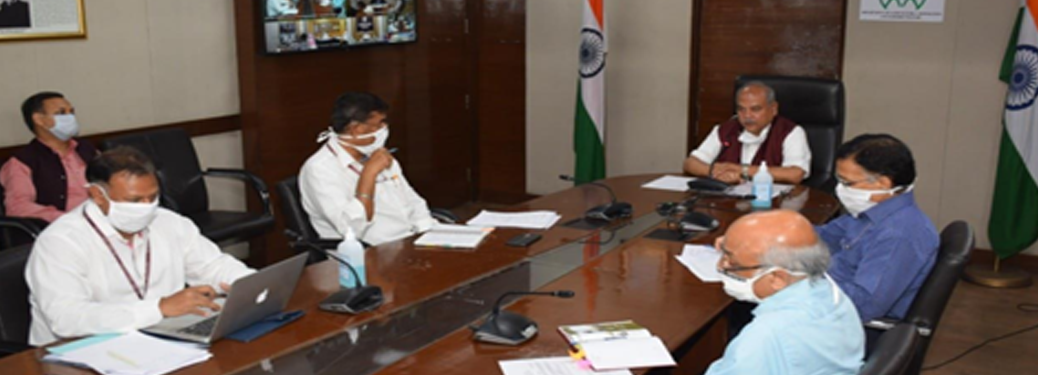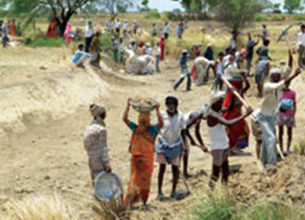SCALING UP WORKS UNDER MGNREGS, PMAY-G, PMGSY, NRLM
27, Apr 2020

Prelims level : Governance
Mains level : GS-II Government Policies and Interventions for Development in Various Sectors and Issues Arising out of Their Design and Implementation.
Why in News?
- Recently, the Union Minister for Rural Development held a Video Conference with Rural Development Ministers and concerned officers of States and Union Territories.
Highlights:
- The meeting was held for scaling up of works under
- Mahatma Gandhi Rural Employment Guarantee Scheme (MGNREGS),
- Pradhan Mantri Awaas Yojana Gramin (PMAY-G),
- Pradhan Mantri Gram Sadak Yojana (PMGSY) and National Rural Livelihood Mission (NRLM) in the light of the relaxation granted by the Ministry of Home Affairs in Non-Containment Areas amid the COVID outbreak.
MGNREGA:
- The Ministry has released the fund to liquidate all outstanding dues of previous years towards wages and materials.
- The Minister assured the States and UTs that adequate financial resources are available for Rural Development Programmes.
- There is the need for the States and UTs to proactively start Rural Development Schemes relating to employment generation, infrastructure creation and strengthening of rural livelihoods while taking all necessary COVID-19 related precautions.
- Under MGNREGS, the focus should be on water conservation, water recharge and irrigation work in convergence with the Schemes of the Ministry of Jal Shakti and Department of Land resources.
MGNREGA – Ministry of Rural Development:
- The Mahatma Gandhi National Rural Employment Guarantee Act (MGNREGA), also known as Mahatma Gandhi National Rural Employment Guarantee Scheme (MNREGS) is Indian legislation enacted on August 25, 2005.
- The MGNREGA provides a legal guarantee for 100 days of employment in every financial year to adult members of any rural household willing to do public work-related unskilled manual work at the statutory minimum wage.
- The Ministry of Rural Development (MRD), Government of India is monitoring the entire implementation of this scheme in association with state governments.
- This act was introduced with an aim of improving the purchasing power of the rural people, primarily semi or unskilled work to people living below poverty line in rural India. It attempts to bridge the gap between the rich and poor in the country. Roughly one-third of the stipulated work force must be women.
- Adult members of rural households submit their name, age and address with photo to the Gram Panchayat.
- The Gram Panchayat registers households after making enquiry and issues a job card.
- The job card contains the details of the adult member enrolled and his/her photo. Registered person can submit an application for work in writing (for at least fourteen days of continuous work) either to Panchayat or to Programme Officer.
- The Panchayat/Programme officer will accept the valid application and issue dated receipt of application, letter providing work will be sent to the applicant and also displayed at Panchayat office.
- The employment will be provided within a radius of 5 km: if it is above 5 km extra wage will be paid.
- Within 15 days of submitting the application or from the day work is demanded, wage employment will be provided to the applicant.
- Right to get unemployment allowance in case employment is not provided within fifteen days of submitting the application or from the date when work is sought.
- Receipt of wages within Fifteen Days of Work Done.
PMAY (G):
- Under this scheme priority would be to complete those housing units where instalments have been given to the beneficiaries.
PMAY(G) – Ministry of Rural Development:
- Housing is one of the basic requirements for human survival.
- In pursuance to the goal of Housing for all by 2022, the rural housing scheme Indira Awas Yojana has been revamped to Pradhan Mantri Awaas Yojana – Gramin and approved during March 2016. Under the scheme, financial assistance is provided for construction of pucca houses to all houseless and households living in dilapidated houses.
- It is proposed that one crore households would be provided assistance for construction of pucca houses under the project during the period from 2016-17 to 2018-19.
- The scheme would be implemented in rural areas throughout India except Delhi and Chandigarh. The cost of houses would be shared between Centre and States.
- Funding Pattern:
- Under PMAY, the cost of unit assistance is to be shared between Central and State Governments in the ratio 60:40 in plain areas and 90:10 for North Eastern and hilly states.
- The unit assistance given to beneficiaries under the programme is Rs 1,20,000 in plain areas and to Rs 1,30,000 in hilly states/difficult areas /Integrated Action Plan (IAP) for Selected Tribal and Backward Districts.
- The unit size is 25 sq.m including a dedicated area for hygienic cooking.
- The beneficiary is entitled to 90 days of unskilled labour from MGNREGA.
- The beneficiary would be facilitated to avail loan of up to Rs.70,000/- for construction of the house which is optional.
- Funds will be transferred electronically directly to the account of the beneficiary.
- Target Group
- Identification of beneficiaries eligible for assistance and their prioritisation to be done using information from Socio Economic and Caste Census (SECC) ensuring total transparency and objectivity.
- The list will be presented to Gram Sabha to identify beneficiaries who have been assisted before or who have become ineligible due to other reasons.
- Under PMGSY, the focus should be on quick award of tenders in sanctioned road projects and starting pending road projects.
- The contractors, suppliers, workers etc should be galvanised to quick start the works.
- Phase I:
- Phase I was launched in December, 2000 as a sponsored scheme with an objective to provide single all-weather road connectivity to eligible unconnected habitation of designated population size.
- 500+ in plain areas and 250+ in North-East, hill, tribal and desert areas,
- 00 – 249 population in LWE districts as per Census, 2001 for overall socio-economic development of the areas.
- Also, upgradation (to prescribed standards) of the existing roads in those Districts where all the eligible Habitations of the designated population size have been provided all-weather road connectivity was to be taken up.
- However, Upgradation is not central to the Programme. In Upgradation works, priority was to be given to Through Routes of the Rural Core Network, which carry more traffic.
- Phase II:
- The Phase II of PMGSY was approved during May, 2013.
- While the ongoing PMGSY – I continued, under PMGSY phase II, the roads already built for village connectivity was to be upgraded to enhance rural infrastructure.
- For the 12thFive Year Plan period a target of 50,000 Km length under PMGSY-II.
- Funding:
- Phase III:
- Phase III was approved by the Cabinet during July 2019.
- It involves consolidation of Through Routes and Major Rural Links connecting habitations to Gramin Agricultural Markets (GrAMs), Higher Secondary Schools and Hospitals.
- Under the PMGSY-III Scheme, it is proposed to consolidate 1,25,000 Km road length in the States. The duration of the scheme is 2019-20 to 2024-25.
- The funds would be shared in the ratio of 60:40 between the Centre and State for all States except for 8 North Eastern and 3 Himalayan States (Jammu & Kashmir, Himachal Pradesh & Uttarakhand) for which it is 90:10.
- NRLM:
- The Ministry appreciated the fact that women SHGs under NRLM are making protective face covers, sanitizers, soaps and are running community kitchens in large numbers.
PMGSY:
PMGSY – Ministry of Rural Development:
1. 75:25 – Centre-state ratio for the upgradation work.
2.90:10 – For hill states, desert areas, Schedule V areas and Naxal-affected districts.
Deen Dayal Antyodaya Yojana – Ministry of Rural Development:
- Deen Dayal Antyodaya Yojana – National Livelihoods Mission (NRLM) was launched by the Ministry of Rural Development (MoRD), Government of India in 2011 as a restructured version of Swarna Jayanti Gram Swarozgar Yojna (SGSY).
- In 2015, the program was renamed Deendayal Antayodaya Yojana (DAY-NRLM).
- Mission:To reduce poverty by enabling the poor households to access gainful self-employment and skilled wage employment opportunities, resulting in appreciable improvement in their livelihoods on a sustainable basis, through building strong grassroots institutions of the poor
- NRLM has set out with an agenda to cover 7 Crore rural poor households, across 2.5 lakh Gram Panchayats and 6 lakh villages in the country through self-managed Self Help Groups (SHGs) and federated institutions and support them for livelihoods collectives in a period of 8-10 years.
- In addition, the poor would be facilitated to achieve increased access to their rights, entitlements and public services, diversified risk and better social indicators of empowerment.
- NRLM believes in harnessing the innate capabilities of the poor and complements them with capacities (information, knowledge, skills, tools, finance and collectivization) to participate in the growing economy of the country.
Key Features:
- Universal Social Mobilisation – At least one-woman member from each identified rural poor household, is to be brought under the Self Help Group (SHG) network in a time bound manner with special emphasis particularly on vulnerable communities.
- Participatory Identification of Poor (PIP) – All households identified as poor through the PIP process are the NRLM Target Group and are eligible for all the benefits under the programme. The NRLM Target Group (NTG) derived through the PIP is de-linked from the BPL.
- Community Funds as Resources in Perpetuity – NRLM provides Revolving Fund (RF) and Community Investment Fund (CIF) as resources in perpetuity to the institutions of the poor, to strengthen their institutional and financial management capacity and build their track record to attract mainstream Bank Finance.
- Financial Inclusion – NRLM works on both demand and supply sides of financial inclusion.
- On the demand side, it promotes financial literacy among the poor and provides catalytic capital to the SHGs and their federations.
- On the supply side, the Mission coordinates with the financial sector and encourages use of Information, Communication & Technology (ICT) based financial technologies, business correspondents and community facilitators like ‘Bank Mitras’.
- Livelihoods – NRLM focuses on stabilizing and promoting existing livelihood portfolio of the poor through its three pillars –
- Vulnerability reduction and Livelihoods enhancement through deepening/enhancing and expanding existing livelihoods options;
- Employment – building skills for the job market outside; and
- Enterprises – nurturing self-employed and entrepreneurs (for micro-enterprises).
- Convergence and partnerships
- Convergence:NRLM places a high emphasis on convergence with other programmes of the MoRD and other Central Ministries.
- Partnerships with NGOs and other CSOs.
- Linkages with PRIs: In view of the eminent roles of Panchayat Raj Institutions (PRIs), it is necessary to consciously structure and facilitate a mutually beneficial working relationship between Panchayats and institutions of the poor, particularly at the level of Village Panchayats.
An opportunity:
- The Minister emphasised that although the challenge posed by the spread of the COVID- 19 epidemic is very serious, this challenge must be perceived as an opportunity by all States/UTs to
- Develop and strengthen rural infrastructure,
- Create employment opportunities in rural areas and
- Facilitate diversification of rural livelihoods.
- To win the fight against coronavirus, proactive States/UTs with the active support of the Union Government, ensuring rural development schemes are implemented in an effective and efficient manner is the need of the hour.







